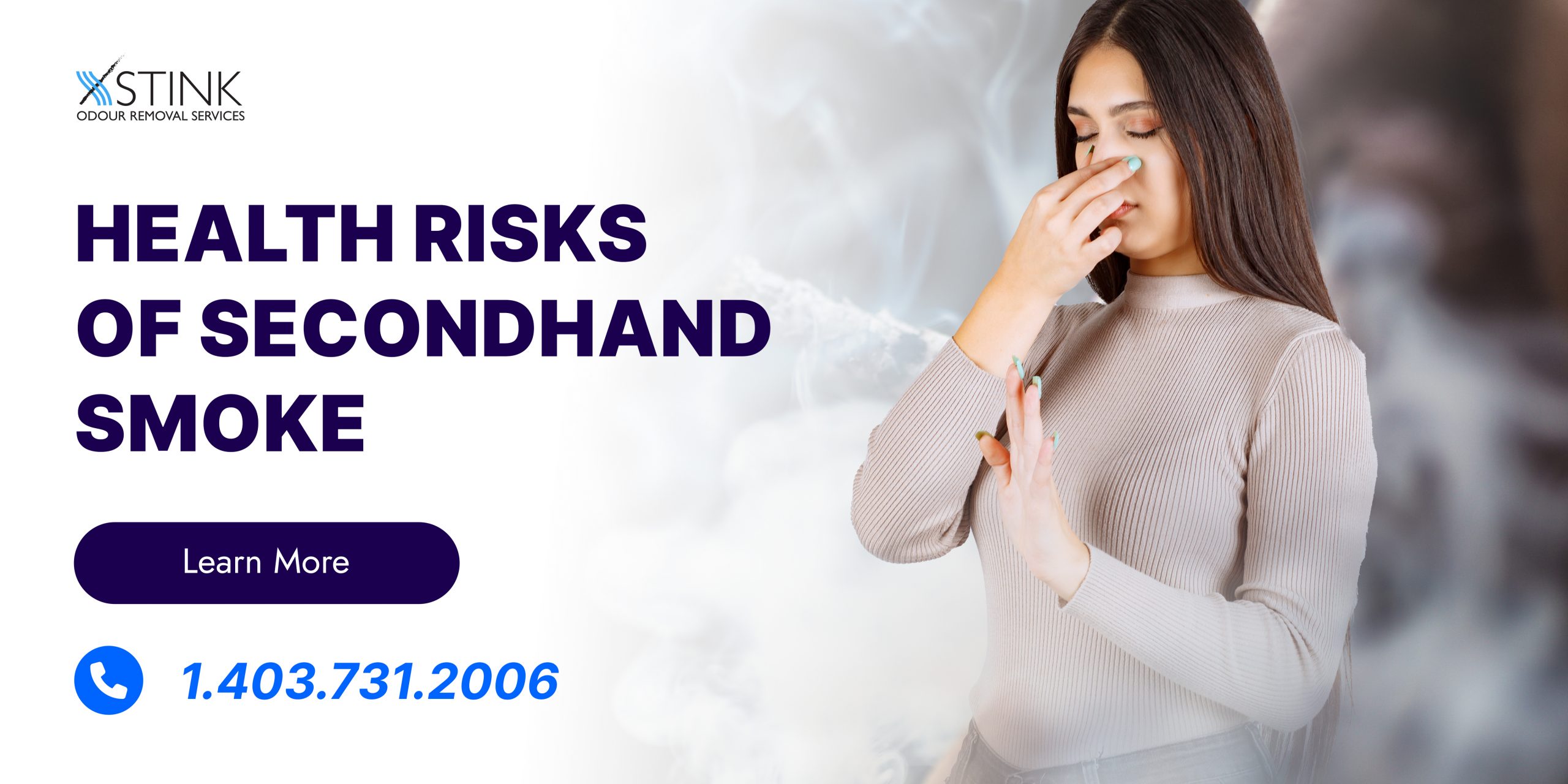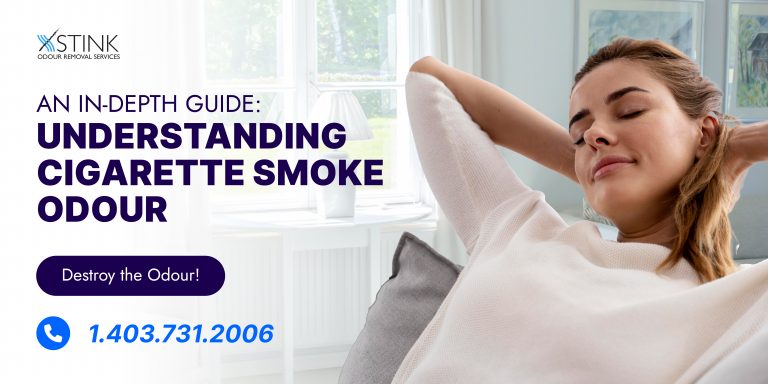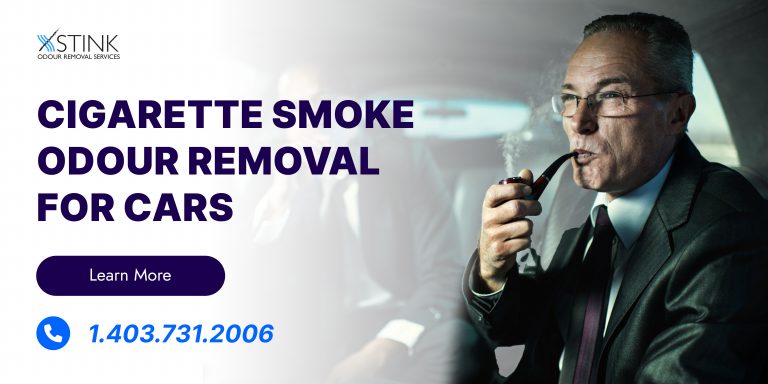Gathered and Shared: Health Risks of Secondhand Smoke
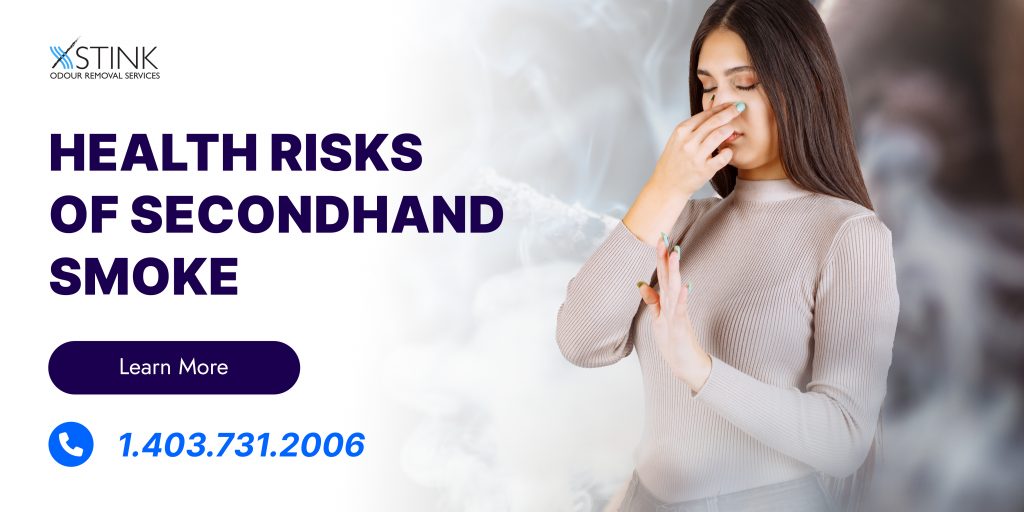
The health risks of secondhand smoke extend far beyond smoking.
It’s a topic of paramount importance, touching the lives of thousands of individuals in Alberta, Canada, who find themselves involuntarily exposed to the harmful effects of passive smoke.
In this blog post, we will delve into the profound impact of secondhand smoke on health, exploring the dire consequences that accompany this pervasive issue.
From respiratory problems to cardiovascular diseases and even an increased risk of cancer, secondhand smoke poses a significant threat to individuals of all ages.
Join us on this journey as we shed light on the risks, the vulnerable groups most affected, and the imperative steps we can take to protect ourselves and our loved ones from this pervasive health hazard.
An Overview of Secondhand Smoke
Have you ever walked into a friend’s house or a commercial building and smelled tobacco smoke odour?
Not only is secondhand smoke dangerous to people, but the odour from secondhand smoke is also a problem for non-smokers and the immune compromised.
Secondhand smoke, also known as passive smoke or environmental tobacco smoke (ETS), is the inhalation of smoke by non-smokers who are in close proximity to smokers.
It consists of two main components: mainstream smoke, exhaled by the smoker, and sidestream smoke, emitted from the burning end of the cigarette.
Secondhand smoke is a complex mixture of over 7,000 chemicals, including nicotine, tar, and various carcinogens.
It poses significant health risks to individuals exposed to it, even if they are not active smokers.
Prevalence of Secondhand Smoke Exposure
The prevalence of secondhand smoke exposure varies across different regions and settings.
In many countries, there have been efforts to reduce exposure through smoking bans in public places and awareness campaigns.
However, exposure to secondhand smoke remains a concern, particularly in private homes, where smoking may occur indoors and in certain occupational settings.
It is important to understand the extent of exposure to develop effective strategies for prevention and protection.
Secondhand smoke, a mix of over 7,000 harmful chemicals, poses significant health risks to non-smokers near smokers. Efforts to reduce exposure are ongoing but remain a concern, particularly in private homes and some workplaces, highlighting the need for effective prevention strategies.
Composition of Secondhand Smoke
Mainstream Smoke
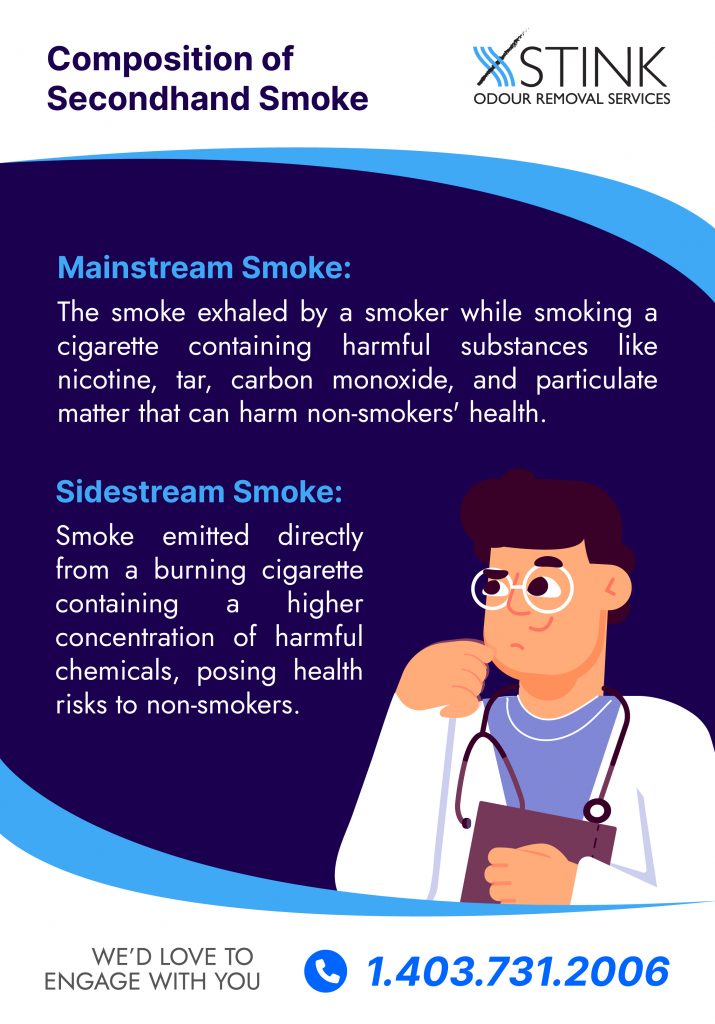
Mainstream smoke is the smoke that is exhaled by a smoker during the act of smoking a cigarette.
It contains a complex mixture of chemicals, many of which are harmful to health. Some of the key components of mainstream smoke include the following:
Nicotine
Nicotine is one of the most well-known and highly addictive components of secondhand smoke. It is a stimulant that affects the central nervous system.
When inhaled through secondhand smoke, nicotine can rapidly enter the bloodstream of non-smokers, leading to increased heart rate, elevated blood pressure, and a sense of alertness.
Even though non-smokers are not actively choosing to use nicotine, exposure to it through secondhand smoke can still lead to addiction, making it challenging for individuals to quit smoking or avoid further exposure.
Tar
Tar is a sticky, brown substance that is produced when tobacco is burned.
It is a major component of secondhand smoke and is notorious for its harmful effects on the respiratory system.
When non-smokers inhale tar from secondhand smoke, it can coat the lining of the lungs and airways, leading to various health problems.
Tar contains many carcinogens and toxic chemicals, which can contribute to the development of lung cancer, chronic bronchitis, and other respiratory diseases.
The presence of tar in secondhand smoke underscores the severe health risks associated with exposure.
Carbon Monoxide
Carbon monoxide (CO) is a colorless, odorless gas present in secondhand smoke, and it poses significant dangers to non-smokers who are exposed to it.
CO binds to hemoglobin in the blood more readily than oxygen does, reducing the blood’s capacity to carry oxygen to vital organs and tissues.
Prolonged exposure to even low levels of carbon monoxide can lead to reduced oxygen supply to the body, which can result in fatigue, headaches, and, in severe cases, heart problems.
Pregnant women exposed to carbon monoxide in secondhand smoke may also face an increased risk of adverse pregnancy outcomes, such as low birth weight and developmental issues in their babies.
Harmful Particulate Matter
Secondhand smoke contains a significant amount of harmful particulate matter, which consists of tiny particles suspended in the air.
These particles are small enough to be inhaled deep into the respiratory system, where they can cause damage.
Particulate matter in secondhand smoke includes tiny droplets of liquid, solid particles, and other pollutants.
When exposed to these particles, non-smokers can irritate the airways, trigger asthma attacks, and exacerbate respiratory conditions.
Additionally, particulate matter in secondhand smoke is a known contributor to indoor air pollution and can negatively affect the overall air quality of indoor environments, posing health risks to everyone present.
Understanding the presence of harmful particulate matter in secondhand smoke highlights the importance of reducing exposure for better respiratory health.
Sidestream Smoke
Sidestream smoke, also known as secondhand smoke, is the smoke that is emitted directly from the burning end of a cigarette.
It is the primary source of secondhand smoke exposure for non-smokers.
Sidestream smoke contains an even higher concentration of harmful chemicals than mainstream smoke because it is produced at a lower temperature and is less filtered by the cigarette’s filter.
The toxic constituents of sidestream smoke include many of the same chemicals found in mainstream smoke, such as nicotine, tar, carbon monoxide, and various carcinogens.
When non-smokers are in close proximity to someone who is actively smoking, they are exposed to sidestream smoke, putting them at risk for a wide range of health problems, including respiratory issues, heart disease, and cancer.
Recognizing the toxic nature of sidestream smoke is essential in understanding the health risks associated with secondhand smoke exposure.
Secondhand smoke contains harmful components like nicotine, tar, carbon monoxide, and particulate matter. Exposure to these substances can lead to addiction, respiratory issues, cardiovascular problems, and developmental risks, highlighting the importance of reducing exposure for better health.
Sources of Secondhand Smoke
Indoor Sources
Smoking in Homes
Smoking in homes is a significant source of secondhand smoke exposure, especially for family members, including children and non-smoking adults, who share living spaces with smokers.
When cigarettes are smoked indoors, the released secondhand smoke lingers in the air and can be inhaled by anyone present.
Even if a designated smoking area is established within the home, the smoke can still permeate through the environment, affecting the entire household.
This continuous exposure to secondhand smoke in homes is a major concern as it puts residents at risk of numerous health issues, ranging from respiratory problems to an increased risk of cardiovascular diseases and cancer.
Effective measures, such as smoking cessation and creating smoke-free homes, are crucial to protect the health of non-smokers.
Smoking in Cars
Smoking in cars, especially when the vehicle is enclosed, can lead to concentrated levels of secondhand smoke exposure.
The limited space in a car allows the smoke to accumulate quickly, making it particularly hazardous for passengers, especially children and pregnant women.
The toxic constituents of secondhand smoke, including nicotine and harmful particulate matter, can become trapped in the enclosed space, leading to poor air quality and potential health problems for those inside.
It is worth noting that the harmful effects of smoking in cars extend beyond the immediate passengers, as residual smoke particles can persist in the car’s upholstery and air ventilation system, contributing to ongoing exposure even when smoking is not occurring.
Efforts to promote smoke-free vehicles and discourage smoking in cars are essential to reduce the risks associated with this indoor source of secondhand smoke.
Public Spaces
Bars and Restaurants
Bars and restaurants have historically been common locations for secondhand smoke exposure due to the prevalence of smoking in such establishments.
Before smoking bans were introduced in many regions, patrons and workers in bars and restaurants were routinely exposed to high levels of secondhand smoke.
This exposure posed significant health risks, including an increased risk of respiratory problems, heart disease, and cancer for both customers and employees.
However, many countries have now implemented smoking bans in indoor public spaces, including bars and restaurants, significantly reducing secondhand smoke exposure in these settings and improving the health and well-being of those who frequent these establishments.
Workplace Exposure
Workplace exposure to secondhand smoke has long been a concern for employees, particularly in settings where smoking is allowed indoors.
Employees who worked in environments where smoking was permitted faced prolonged and concentrated exposure to secondhand smoke, leading to an increased risk of health problems.
These health issues included respiratory ailments, cardiovascular diseases, and a heightened risk of certain types of cancer.
In response to growing awareness of the health risks associated with secondhand smoke exposure, many countries have enacted laws and regulations prohibiting smoking in the workplace.
These measures have not only improved the health and safety of workers but have also contributed to a healthier work environment overall.
Public Transport
Public transport, such as buses, trains, and subways, used to be places where non-smokers were at risk of secondhand smoke exposure due to the confined spaces and shared air.
Passengers who were exposed to secondhand smoke during their commutes faced potential health hazards, including respiratory problems and discomfort.
Many public transport authorities have implemented strict no-smoking policies on their vehicles and in station areas, recognizing the importance of providing smoke-free environments for all passengers.
These policies have made public transport a more pleasant and healthier experience for commuters and reduced the risks of secondhand smoke exposure during travel.
Secondhand smoke exposure comes from indoor sources like homes, cars, and public spaces, including bars, restaurants, workplaces, and public transport. Smoking bans and no-smoking policies have reduced these risks, promoting healthier environments and better well-being for all.
Health Risks and Impact
Adults
Respiratory Problems
Adult non-smokers exposed to secondhand smoke are at risk of experiencing various respiratory problems.
The toxic chemicals and irritants in secondhand smoke can inflame the airways and lead to symptoms such as coughing, wheezing, and shortness of breath.
Prolonged exposure can exacerbate preexisting respiratory conditions like asthma and chronic bronchitis.
Additionally, secondhand smoke exposure has been linked to the development of chronic obstructive pulmonary disease (COPD) in non-smokers.
These respiratory problems reduce the quality of life for affected individuals, resulting in increased healthcare costs and lost productivity.
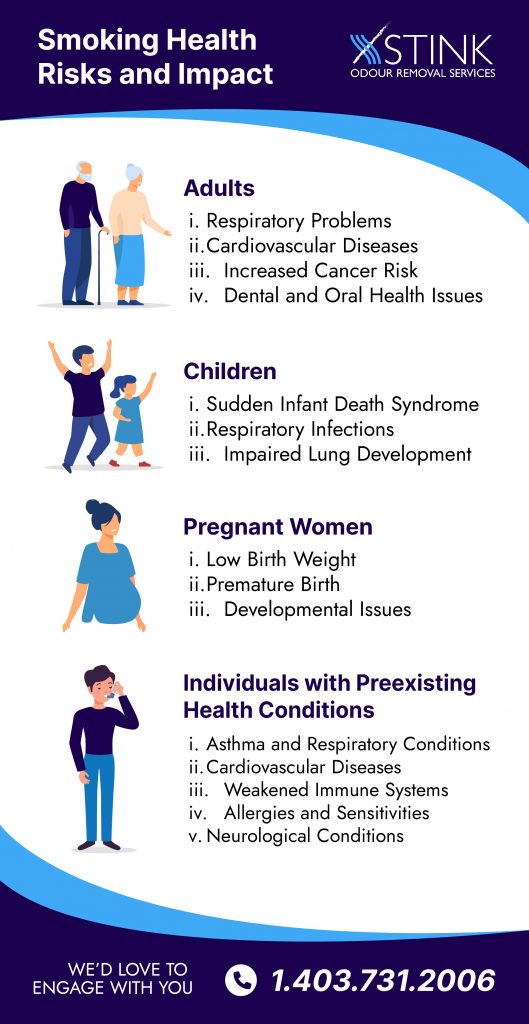
Cardiovascular Diseases
Exposure to secondhand smoke poses a significant risk of cardiovascular diseases in non-smoking adults.
The chemicals in secondhand smoke, such as carbon monoxide and fine particulate matter, can lead to blood vessel constriction, elevated blood pressure, and the formation of blood clots.
These effects increase the risk of heart attacks and strokes in non-smokers who are regularly exposed to secondhand smoke.
The impact on cardiovascular health is particularly concerning, as it can lead to life-threatening conditions.
Reducing exposure to secondhand smoke is vital in safeguarding the cardiovascular well-being of non-smoking adults.
Increased Cancer Risk
Non-smoking adults exposed to secondhand smoke face an elevated risk of developing cancer, particularly lung cancer.
Secondhand smoke contains carcinogens such as benzene and formaldehyde, which can damage DNA and form cancerous cells.
While the risk of cancer from secondhand smoke is lower than for active smokers, it remains a significant concern.
Additionally, exposure to secondhand smoke has been associated with an increased risk of other cancers, including breast cancer and nasal sinus cancer.
These findings underscore the importance of reducing secondhand smoke exposure to protect non-smoking adults from the potentially life-threatening consequences of cancer.
Dental and Oral Health Issues
Secondhand smoke exposure has been linked to dental and oral health problems in non-smoking adults.
It can contribute to issues such as gum disease, tooth decay, and compromised overall oral health.
The toxins and chemicals in secondhand smoke can harm oral tissues, leading to inflammation and an increased risk of dental problems.
Additionally, non-smokers exposed to secondhand smoke may experience a heightened risk of developing oral cancers, including cancers of the mouth, throat, and lips.
Protecting oral health is another important aspect of reducing the health risks associated with secondhand smoke exposure in adults, highlighting the interconnectedness of overall health and well-being.
Children
Sudden Infant Death Syndrome (SIDS)
Sudden Infant Death Syndrome (SIDS) is a deeply distressing and unexplained phenomenon in which seemingly healthy infants die suddenly during their sleep.
One significant risk factor for SIDS is exposure to secondhand smoke, especially during pregnancy and in the early months of a child’s life.
Infants exposed to secondhand smoke are at a significantly higher risk of SIDS.
The toxic components of secondhand smoke can impair an infant’s ability to regulate their breathing and disrupt their nervous system, making them more vulnerable to this devastating condition.
SIDS remains a tragic and heartbreaking occurrence, underscoring the importance of maintaining smoke-free environments during pregnancy and early childhood.
Respiratory Infections
Children exposed to secondhand smoke are more susceptible to respiratory infections, including bronchitis, pneumonia, and frequent colds.
The irritants and harmful substances in secondhand smoke weaken a child’s developing immune system and damage the delicate tissues of their respiratory tract.
As a result, they may experience more severe and frequent respiratory illnesses, which can lead to missed school days and a lower quality of life.
Furthermore, repeated respiratory infections in childhood can have long-term consequences for lung health, making children more vulnerable to respiratory conditions in adulthood.
Protecting children from secondhand smoke exposure is crucial in safeguarding their respiratory health and overall well-being.
Impaired Lung Development
Exposure to secondhand smoke can interfere with the normal development of a child’s lungs, potentially leading to long-term health problems.
Children exposed to secondhand smoke may experience impaired lung growth and function, which can persist into adulthood.
This can result in reduced lung capacity, increased susceptibility to asthma, and a higher risk of developing chronic obstructive pulmonary disease (COPD) later in life.
Impaired lung development during childhood can have lifelong implications for respiratory health, underscoring the critical importance of creating smoke-free environments for children.
Protecting their lungs from the harmful effects of secondhand smoke is essential to ensuring they have the best chance of healthy growth and development.
Pregnant Women
Low Birth Weight
Pregnant women exposed to secondhand smoke face an increased risk of giving birth to babies with low birth weight.
Low birth weight, defined as infants born weighing less than 2.5 kilograms (5.5 pounds), can have serious health implications.
Secondhand smoke contains toxins like nicotine and carbon monoxide, which can reduce blood flow to the developing fetus and limit the transfer of oxygen and nutrients.
This restriction in growth can lead to low birth weight, which, in turn, increases the risk of health problems for the baby, such as respiratory distress syndrome, developmental delays, and a greater likelihood of illness during infancy.
Pregnant women are strongly advised to avoid exposure to secondhand smoke to reduce the risk of low birth weight and its associated health challenges.
Premature Birth
Exposure to secondhand smoke during pregnancy is also associated with an increased risk of premature birth, which occurs when a baby is born before 37 weeks of gestation.
Premature birth can lead to a host of health issues for both the infant and mother.
The toxic chemicals in secondhand smoke can trigger inflammation and uterine contractions, potentially causing preterm labor.
Babies born prematurely may experience complications such as respiratory distress syndrome, developmental delays, and a higher risk of long-term health problems.
Pregnant women are encouraged to prioritize smoke-free environments to reduce the risk of preterm birth and its associated health challenges for both mother and child.
Developmental Issues
Secondhand smoke exposure during pregnancy can adversely affect the unborn child’s developmental trajectory.
The toxic components of secondhand smoke can disrupt the development of the baby’s brain and organs, potentially leading to developmental issues later in life.
Children exposed to secondhand smoke in utero may be at a higher risk of cognitive and behavioral problems, such as attention deficit hyperactivity disorder (ADHD) and learning disabilities.
These developmental challenges can have lasting implications for a child’s educational attainment and overall well-being.
Therefore, creating smoke-free environments for pregnant women is vital to ensuring the healthy development of their unborn children and reducing the risk of developmental issues.
Individuals with Preexisting Health Conditions
Asthma and Respiratory Conditions
Individuals with preexisting asthma and respiratory conditions are especially vulnerable to the adverse effects of secondhand smoke.
Secondhand smoke contains irritants and allergens that can trigger asthma attacks, worsen chronic obstructive pulmonary disease (COPD), and exacerbate respiratory symptoms.
Exposure to secondhand smoke can lead to increased coughing, wheezing, breathlessness, and a decreased quality of life for these individuals.
Managing asthma and other respiratory conditions becomes more challenging in the presence of secondhand smoke, highlighting the importance of smoke-free environments to protect those with preexisting respiratory health challenges.
Cardiovascular Diseases
People with preexisting cardiovascular diseases, such as heart disease and hypertension, are at a heightened risk when exposed to secondhand smoke.
The toxins in secondhand smoke can lead to blood vessel constriction, increased blood pressure, and an elevated risk of heart attacks and strokes.
Exposure to secondhand smoke can also impair the functioning of the cardiovascular system, exacerbating existing conditions and worsening overall cardiovascular health.
For individuals with heart-related ailments, avoiding secondhand smoke is imperative in mitigating the risk of life-threatening cardiovascular events.
Weakened Immune Systems
Individuals with weakened immune systems, such as those undergoing cancer treatment or living with autoimmune diseases, are more susceptible to infections and complications arising from secondhand smoke exposure.
Secondhand smoke contains pathogens and toxic substances that can compromise immune systems’ ability to fend off infections.
Consequently, these individuals are at a higher risk of respiratory infections, pneumonia, and other health issues resulting from secondhand smoke exposure.
Maintaining smoke-free environments and minimizing exposure is crucial in protecting the health of those with weakened immune systems.
Allergies and Sensitivities
When exposed to secondhand smoke, individuals with allergies and sensitivities may experience exacerbated symptoms.
The chemicals and irritants in secondhand smoke can trigger allergic reactions, worsen existing allergies, and lead to discomfort.
Symptoms may include nasal congestion, sneezing, itchy eyes, and skin rashes.
Reducing exposure to secondhand smoke is vital for individuals with allergies and sensitivities to maintain their quality of life and minimise health disruptions.
Neurological Conditions
For individuals with preexisting neurological conditions, such as epilepsy or multiple sclerosis, exposure to secondhand smoke can pose additional risks.
The toxins in secondhand smoke can potentially exacerbate symptoms and complicate the management of these conditions.
Neurological conditions can be sensitive to environmental factors, and secondhand smoke exposure may trigger seizures or worsen cognitive symptoms.
Ensuring smoke-free environments is essential in supporting the well-being of individuals with preexisting neurological conditions and minimising potential health complications.
Secondhand smoke poses health risks to various groups, including respiratory issues, cardiovascular diseases, cancer, dental problems, SIDS, respiratory infections, impaired lung development, low birth weight, premature birth, developmental issues, and worsened conditions for those with existing health problems.
The Role of Professional Cigarette Odour Removal
Importance of Odour Removal
The importance of professional cigarette odour removal cannot be overstated, especially in indoor environments where smoking has taken place.
Cigarette smoke carries a distinctive and persistent odour that can permeate walls, furniture, fabrics, and other surfaces.
This odour can linger long after the actual smoking has occurred, making indoor spaces unpleasant and unhealthy for occupants.
Beyond the discomfort it causes, the odour of cigarette smoke may also trigger respiratory discomfort and allergic reactions in some individuals.
Additionally, the smell of smoke can negatively affect the perceived cleanliness and overall appeal of indoor spaces, such as homes, hotels, and vehicles.
Therefore, professional cigarette odour removal plays a vital role in restoring indoor air quality, creating a more pleasant and inviting environment, and safeguarding the well-being of occupants.
Methods of Professional Cigarette Odour Removal
Air Purification Systems
Air purification systems are effective tools in the professional removal of cigarette odours.
These systems are designed to filter and clean the indoor air, removing airborne particles and odour-causing molecules.
High-efficiency particulate air (HEPA) filters and activated carbon filters are commonly used in air purifiers to trap smoke particles and adsorb odour molecules.
By continuously circulating and purifying the air, these systems can significantly reduce the presence of cigarette odour.
Some advanced air purifiers are equipped with sensors that detect changes in air quality and adjust their operation accordingly, providing efficient odour removal.
Cleaning and Surface Treatment
Professional cleaning and surface treatment methods are essential for removing cigarette odour from walls, ceilings, floors, and furnishings.
Cleaning involves the thorough removal of smoke residues, such as nicotine and tar, from surfaces using specialised cleaning agents and techniques.
In addition to cleaning, surface treatment may involve applying sealants or odour-neutralising products to prevent odour molecules from re-emerging over time.
Professional cleaners use their expertise to target odour sources, ensuring that all affected areas are properly treated.
This comprehensive approach helps eliminate both the visible and invisible remnants of cigarette smoke.
Ventilation Improvements
Adequate ventilation is crucial for reducing indoor cigarette odours.
Professional odour removal may include improvements to ventilation systems, such as installing high-efficiency particulate air (HEPA) filters or adjusting airflow rates to enhance the removal of smoke particles and odour from indoor spaces.
Proper ventilation helps dilute and disperse odour molecules, improving overall indoor air quality.
In some cases, professionals may recommend the installation of smoke-specific ventilation systems in areas where smoking is allowed, further preventing the spread of odour to smoke-free zones.
By addressing ventilation issues, professionals can help maintain smoke-free and odour-free environments for the occupants of indoor spaces.
Benefits of Professional Cigarette Odour Removal
Health Benefits
Professional cigarette odour removal offers significant health benefits to occupants of indoor spaces where smoking has occurred.
Prolonged exposure to residual cigarette odour can potentially harm respiratory health, particularly for individuals with preexisting conditions such as asthma or allergies.
The lingering odour can irritate the airways, trigger symptoms, and worsen overall well-being.
Professional services mitigate these health risks by effectively removing cigarette odor, making indoor environments safer and more comfortable for everyone.
Furthermore, for those attempting to quit smoking, a smoke-free and odour-free environment can support their journey toward smoking cessation, contributing to improved long-term health outcomes.
Improved Indoor Air Quality
Professional cigarette odour removal significantly enhances indoor air quality by eliminating the harmful chemicals and particulate matter associated with cigarette smoke.
Cigarette smoke contains numerous toxic substances that can linger in the air and settle on surfaces, degrading the overall quality of indoor air.
These pollutants can contribute to respiratory problems, eye irritation, and general discomfort for occupants.
Professional odour removal services restore the freshness and cleanliness of indoor air by effectively removing these odor-causing molecules and particles.
Improved indoor air quality creates a healthier and more pleasant living or working environment, reducing the potential for adverse health effects associated with poor air quality.
Creating Smoke-Free Environments
Perhaps one of the most valuable benefits of professional cigarette odour removal is the creation of entirely smoke-free environments.
Such environments are crucial for promoting health and well-being, particularly in spaces shared by individuals who may have different attitudes toward smoking.
A smoke-free environment ensures that non-smokers are not subjected to the health risks of secondhand smoke while respecting smokers’ rights and preferences.
It encourages a positive shift in social norms towards healthier choices and smoking cessation, ultimately contributing to a culture of wellness.
Additionally, smoke-free environments can improve the marketability and appeal of residential and commercial properties, as they are more attractive to a broader range of individuals seeking clean and odour-free spaces for living and business activities.
Considerations for Implementing Professional Odour Removal
Cost and Investment
Implementing professional cigarette odour removal services involves financial considerations, including the cost of hiring professionals and purchasing any necessary equipment or products.
The extent of the cost can vary depending on factors such as the size of the space, the severity of the odour, and the specific methods used for odour removal.
While an initial investment is associated with professional services, viewing this expenditure as an investment in health, comfort, and property value is important.
The benefits of odour removal, including improved indoor air quality and the creation of a smoke-free environment, can outweigh the upfront costs.
Moreover, some individuals may qualify for financial assistance or insurance coverage to help offset these costs, making professional odour removal a viable option for many.
Maintenance and Sustainability
Maintaining the results of professional cigarette odour removal is a critical consideration for long-term success.
After the initial odour removal process, it’s important to implement preventive measures to avoid the recurrence of odour problems.
These measures may include enforcing smoking policies, promoting smoke-free environments, and conducting routine cleaning and maintenance to prevent odour buildup.
Sustainability is also a key factor in the environmental impact of odour removal methods and products.
Choosing sustainable and eco-friendly options for odour removal aligns with broader environmental goals and reduces the ecological footprint of the process.
It’s essential to strike a balance between effective odour removal and sustainable practices to ensure long-lasting results that benefit both occupants and the environment.
Professional cigarette odour removal is essential for eliminating the persistent odour of cigarette smoke from indoor spaces. It improves indoor air quality, promotes health, and creates smoke-free environments. Methods include air purification, cleaning, and ventilation improvements. The benefits include better health, enhanced air quality, and the creation of cleaner, more attractive spaces.
Prevention and Awareness
Education Campaigns
Education campaigns play a pivotal role in raising awareness about the health risks associated with secondhand smoke and the importance of prevention.
These campaigns are designed to inform the public about the dangers of secondhand smoke exposure, targeting both smokers and non-smokers.
Through various media channels, educational materials, and community outreach, campaigns provide information about the health consequences of secondhand smoke on individuals and communities.
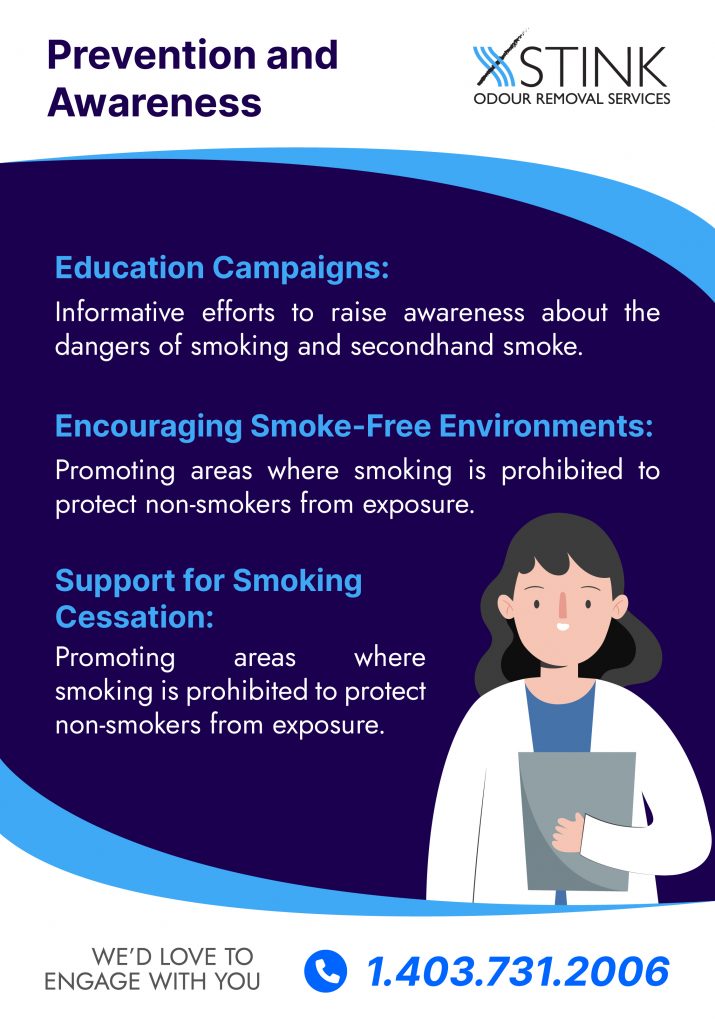
They also emphasize the vulnerability of specific groups, such as infants, pregnant women, and individuals with preexisting health conditions.
By increasing awareness, education campaigns encourage individuals to make informed choices, reduce exposure, and support smoke-free policies.
Encouraging Smoke-Free Environments
Promoting smoke-free environments is fundamental to preventing secondhand smoke exposure.
This involves advocating for the implementation of smoke-free policies in public places, workplaces, and residential settings.
Efforts to encourage smoke-free environments aim to protect non-smokers from the health risks of secondhand smoke and create spaces where individuals can live, work, and socialize without exposure to tobacco smoke.
Encouraging smoke-free environments also involves supporting initiatives to restrict smoking in outdoor areas, further reducing exposure in shared spaces.
By fostering a culture that values smoke-free living and respecting the rights of non-smokers, communities can significantly reduce the prevalence of secondhand smoke.
Support for Smoking Cessation
Supporting smoking cessation is a crucial component of preventing secondhand smoke exposure.
Individuals who quit smoking improve their health and contribute to the well-being of those around them by eliminating the source of secondhand smoke.
Prevention efforts include providing access to smoking cessation resources, such as counselling, nicotine replacement therapies, and medications, to help smokers quit successfully.
Support systems that understand the challenges of quitting, provide encouragement, and offer coping strategies can significantly increase the likelihood of quitting.
By offering comprehensive support for smoking cessation, communities can reduce the number of active smokers and, consequently, the extent of secondhand smoke exposure in society.
This multi-faceted approach addresses both the prevention and reduction of secondhand smoke exposure, ultimately improving public health.
FAQs in Relation to the Health Risks of Secondhand Smoke
What is secondhand smoke, and why is it harmful to health?
Secondhand smoke, also known as passive smoke or environmental tobacco smoke, is the combination of the smoke exhaled by a smoker (mainstream smoke) and the smoke emitted from the burning end of a cigarette (sidestream smoke).
It is harmful because it contains over 7,000 toxic chemicals, including hundreds and about 70 known to cause cancer.
Exposure to these chemicals through secondhand smoke can lead to a range of serious health problems in non-smokers, including respiratory issues, cardiovascular diseases, and an increased risk of cancer.
How can I protect myself and my family from secondhand smoke at home?
The most effective way to protect yourself and your family from secondhand smoke at home is to establish a completely smoke-free environment indoors.
Ensure that no one smokes inside the house or in enclosed spaces. Designate outdoor smoking areas, if necessary, and encourage smokers to use them.
Properly ventilate your home by opening windows and using air purifiers with HEPA and activated carbon filters.
Educate family members about the dangers of secondhand smoke and the importance of smoke-free living.
Are there health risks associated with exposure to secondhand smoke outdoors?
While the risks are lower outdoors than indoors, exposure to secondhand smoke outdoors can still be harmful, especially in areas with poor ventilation or close proximity to smokers.
Outdoor exposure can contribute to respiratory discomfort and discomfort for non-smokers.
In some regions, outdoor smoking bans are in place to protect public health, particularly in crowded areas like parks and outdoor dining spaces.
Can pregnant women be exposed to secondhand smoke?
Pregnant women should avoid exposure to secondhand smoke as it can have serious consequences for both the mother and the developing baby.
Secondhand smoke during pregnancy is associated with an increased risk of low birth weight, premature birth, developmental issues, and complications during pregnancy and childbirth.
It’s essential for pregnant women to stay in smoke-free environments to protect the health of themselves and their unborn children.
How can I encourage someone to quit smoking to reduce secondhand smoke exposure?
Encouraging someone to quit smoking can be challenging but is essential for their health and the health of those around them. Approach the conversation with empathy and understanding.
Offer support by helping them find resources such as smoking cessation programs, nicotine replacement therapies, or counseling services.
Share information about the health risks of smoking and secondhand smoke exposure.
Be patient, and let them know that you care about their well-being and are willing to assist them on their journey to quitting.
Secondhand Smoke Poses Serious Health Risks, Demanding Urgent Action to Safeguard Well-Being
In conclusion, the health risks of secondhand smoke are undeniable and pervasive, affecting not only smokers but also countless non-smokers, including vulnerable groups like children, pregnant women, and those with preexisting health conditions.
The toxic cocktail of chemicals in secondhand smoke can lead to a range of serious health problems, including respiratory issues, cardiovascular diseases, and an increased risk of cancer.
To safeguard ourselves and our loved ones from these risks, it’s imperative that we take a proactive stance.
Start by creating and maintaining smoke-free environments in your homes and workplaces.
Additionally, encourage smokers to seek professional help to quit smoking, recognizing that their choice to quit benefits them and the well-being of those around them.
Professional support, including smoking cessation programs and guidance from healthcare providers, can make a significant difference in helping individuals break free from the grip of tobacco addiction.
Moreover, reach out to XStink Odour Removal Services for professional cigarette odour removal services to ensure that your indoor spaces are smoke-free and free from the lingering effects of tobacco odour.
By working together, we can actively contribute to a smoke-free future where the health and safety of all individuals are prioritized, saving lives and creating healthier environments for generations to come.

